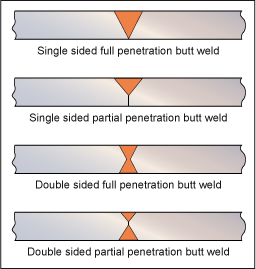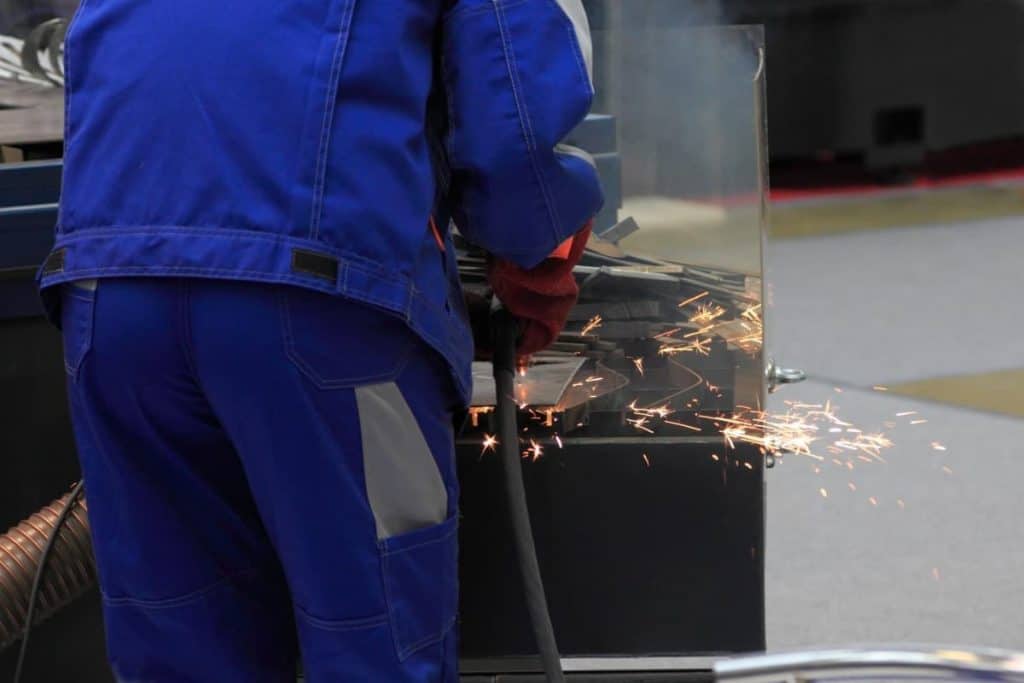Welding can have a certain appeal for many people. Set up the metals, drop the visor, strike an arc, and get down to business. What could be just a pile of metal parts a few hours ago would emerge from the blinding white heat as something practical and useful. But understanding butt welds is important to making this happen.
So what is a butt weld? A butt weld is the most common type of joint that is used in the fabrication of structures and piping systems. It is a circumferential weld joint where the molten metal is applied around the joint.
The power to mold and shape new, valuable equipment or complete structures out of just some random pieces of metal can be exhilarating, and this is one of the reasons why many people join the profession. It is not just a living, but a passion for welders.
What is a butt weld?
As metal fabricators, we can saw, shear, grind, bend, punch, notch, and polish complex structures. Welding is where the real magic happens. Ordinary parts are combined and joined together to create gates and fences around your property, frame extensions for vehicles, and additional utility for machinery.
Making good quality welds requires both knowledge and practice, especially about welds. There are only two main types of continuous weld you can make, the fillet weld and the butt joint weld. Some welders will note that there are more, but in essence, they are all just modifications of the fillet or butt weld.
Two pieces of base metals are brought together and either fixed on a workbench or mounts. Typically there will be a gap of around 1/8” (3mm) between the metals. The welder strikes an arc and feeds the filler into the gap, creating a puddle of molten metal. The pool is then moved along the length of the joint with additional filler added in a continuous stream.
The gap is left between the metals to ensure molten metal penetrates deep inside the pieces being joined together. If the gap between the metals is left too small, the metal may not penetrate deep enough. If you leave a gap that is too big, you will get a large seam on the opposite side of the pieces.
The metal thickness also impacts the level of penetration. If your metal pieces are more than 3/16” a chamfer is usually applied on one or both top edges. This can make the gap wider and lets the metal flow down the full thickness of the metals more efficiently. Conversely, if the metal pieces are too thin, it may not be necessary to leave a gap between the parts at all.
Types of butt weld joints
Butt welds are made in a variety of ways, and each one serves a different purpose. The typical examples of butt weld joints include the following:

Square butt weld
The square butt weld is mainly used for projects where metals are 3/16 inch or less in thickness. The square butt weld joint is quite strong, but it is not recommended where the completed structure will be subject to impact loads or fatigue over prolonged use.
It is effortless to prepare the joint since it only requires connecting the edges of the metal plates. However, it is essential to fit the metals together accurately for the entire length of the joint to get the best result. It is also necessary to allow enough root opening for the joint to let the filler material penetrate deep inside.
Grooved butt weld
If you are looking to weld metals that are more than 3/16 inch in thickness, you will probably need to use the grooved butt joint. The purpose of grooving the metal plates is to give the joint the necessary strength. Thicker metals have more space to deposit the filler, and grooving the sheets results in a more durable bond.
If you are applying the grooved weld for your project, it is vital to keep the angle of the groove sufficient to allow the electrode to pour into the joint. If the groove is too narrow, the filler will not penetrate deep enough and crack after some time. However, you also need to avoid excess beveling of the metal sheet because this can waste both the weld metal and time without giving you the necessary benefit.
The groove butt weld joint can either be single-grooved on one side only or double-grooved, with grooves on both sides. This depends mostly on the thickness of the metal and the type of welds that you need to make. Thicker metals can be grooved on both sides, while thin sheets should only be grooved on one side. If you work on a variety of projects, you will probably need to use both, so it is best to learn both styles.
V butt weld
The single V butt weld is more common on frames that are 1/4 inch to 3/4 inch in thickness. The beveled angle for the joint is around 60 degrees for plate and 75 degrees for pipe, in general. You can prepare the metal with the help of a particular beveling machine or cutting torch. The V-shaped weld is more costly to prepare than a square butt joint. You also need more filler material for this weld than the square joint.
The benefit is that this weld is stronger than the square butt joint. However, it is not recommended if the completed structure is bent at the root of the weld.
Double V butt weld
The double V butt weld is excellent for a variety of projects. Its main benefit is for metals that are thicker than 3/4 inch that can be grooved on both sides. However, it can be used on thinner metal plates, where load strength is critical.
It takes longer to prepare a double V weld than a single-V joint. The amount of filler material required is smaller; however, as the space between the two grooves is narrower than it would be for a single V groove on one side only.
As the welder produces a lot of heat during production, you should alternate when making welds for a double V joint. Run the welder for the whole length of the metal on one side and let it cool before following through on the other side. This helps produce a more symmetrical joint and minimizes the chance of warpage.
Advantages of butt welds
Many welders prefer to use the butt weld on their projects because it creates a reasonably strong weld, and it is easy to apply for different situations. It offers the following advantages for users.
- Multiple butt welds can be created over the complete joint area in a variety of section sizes and shapes. For example, butt welds are used on everything from bicycle wheel rims to railway rails. You do need to ensure that the sections that are joined should match closely. You can also create miter joints with butt welding, such as the ones you may have seen in welded metal window frames.
- The weld can be performed for a large variety of materials such as steels, aluminum, stainless steel, nickel alloys, and titanium, etc.
- The weld creates a solid, phase joint. Any molten metal and contaminants formed at the point of impact are squeezed out into the upset during the heating process. This ensures that solidification, porosity, and cracking are not an issue.
- The welding process can be completed automatic or semi-automatic without hitting the arc at a different angle. You can monitor the joint after each hit to determine weld quality.
- The butt welded joint is powerful and permanently sealed.
- It is ideal for continuous steel structure in pipes as the joints between the fittings and pipes in the piping system are of good strength.
- Butt welds generally have a smooth surface as the filler is deposited into the groove.
- Butt-welded pipe fittings are low cost.
- The butt welded joints occupy less space in a structure.
Butt weld filler material
Steel rods should be clamped under force to bring them together for butt welding. In most cases, you will use class 3 copper for welding metal. It is a good conductor and offers good mechanical wear, strength, and durability.
The steel flash or bulge that may be created during the butt weld should be removed. You can do this by hand or with nippers.
What is the difference between socket weld and butt weld?
There are several differences between a socket weld and a butt weld. For example, there’s a different seam and groove between the two, a different detection, a different application, and they have different costs. You can read about more of the differences here.
What is tee joint welding?
Tee joints are utilized to weld two plates or segments with surfaces situated roughly 90 degrees to one another in the joint. However, the surface of a single plate or part isn’t in precisely the same plane as the conclusion of another surface.
What are the welding bevel standards?
In many instances of beveling pipe, as an instance, the normal bevel is a 37.5-degree angle. The key issue to keep in mind is this: whatever the level, having the ability to maintain that angle inside the tolerance level is just one crucial key to a fantastic bevel.

